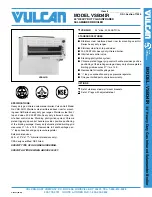
104
4.1
D.H.W. TANK UNIT
The enamelled D.H.W. tank comes with a
magnesium anode to protect the boiler and
an inspection flange for checking and clea-
ning.
The magnesium anode must be
checked annually and replaced if it is
worn.
It is advisable to place a sluice gate
at the entrance of the D.H.W. tank unit
which, apart from the total closure, allows
the regulation of the supply capacity.
When the boiler does not produce hot
water, make sure that the air has been
released by acting on the manual vents
after having turned the main switch off.
4.2
CONTROL OF THE GAS
PRESSURE UPSTREAM
OF THE BOILER
If the upstream pressure is between 11.5
and 15 mbar the boiler is functioning, thou-
gh at an inferior maximum nominal power.
In case of pressure less than 11.5 mbar
the gas pressure switch acts.
4.3
GAS VALVE
The boiler model SIT 845 SIGMA (fig. 14) is
produced with gas valve set at two pressu-
re values: maximum and minimum, that
correspond according to the type of gas to
the values indicated in
Table 2
.
The setting of the gas pressure at mini-
mum and maximum values is carried out by
SIME: variations are discouraged.
Only in the passing from one type of gas
supply (methane) to another (propane) is a
change in the working pressure allowed.
Such an operation must be carried out by
authorised personnel, or the guarantee
will lose validity. Once the change in
working pressure has been carried out,
seal the regulators.
When proceeding with the setting of the
pressure, it is necessary to follow a pre-
es t ablished or der, regulating fir s t the
MAXIMUM and then the MINIMUM.
4.3.1
Maximum and minimum
pressure adjustment
In order to carry out the setting of the maxi-
mum proceed in the following way (fig. 15):
–Connect a dif ferential manometer as
shown in fig. 14.
– Remove the plastic cap of the modula-
tor (1).
–Start the boiler by pressing on the four
way switch.
–Place the heating potentiometer knob on
the maximum value.
–Using a ø 10 wrench turn the nut (3) to
find the maximum pressure as shown in
Table 2
: to reduce the pressure turn the
nut anti-clockwise, to increase the pres-
sure turn the nut clockwise.
–Turn of f and turn on the burner 2-3
times to verify that the pressure corre-
sponds to the values given in
Table 2
.
After having regulated the maximum pres-
sure, proceed with the setting of the mini-
mum pressure.
–Disconnect the electric supply of the
modulator.
– With the heating potentiometer knob on
the maximum value and the burner alight,
holding the nut (3) blocked, turn the screw
(2) to find the minimum pressure value as
shown in
Table 2
: to decrease the pressure
turn the nut anti-clockwise and to increase
the pressure turn the nut clockwise.
–Turn on and turn of f the burner 2-3
times to verify that the pressure corre-
sponds to the values given in
Table 2
.
–Reconnect the electrical supply of the
modulator.
–Replace the plastic cap (1).
4.4
ADJUSTMENT
OF HEATING
OUTPUT
To regulate the heat putput, modifying the
fact or y settings, which is the minimum
thermal power for each model (17.8 - 24.1
kW), it is necessary to work with a screw-
driver on the trimmer of the heating power
(10 fig. 10).
To increase the operating pressure turn
the trimmer in a clockwise direction, to
decrease the pressure turn the trimmer in
an anti-clockwise direction.
To facilitate the search for the adjusting of
the heating power the diagrams pressu-
re/heat output for natural gas (methane)
and propane gas are available (figs. 16 -
16/a). To ensure proper operation, check
that the burner flame looks like the one
shown in fig. 17.
3
2
1
Fig. 15
KEY
1
Plastic cap
2
Screw regulation minimum pressure
3
Nut regulation maximum pressure
4
USE AND MAINTENANCE
TABLE 2
3
4
2
1
5
Fig. 14
KEY
1
Modulator
2
EV1-EV2 coils
3
Upstream pressure plug
4
Downstream pressure plug
5
Manometer
22
32 - 32/50 - 32/80
Methane - G20
Maximum burner pressure
mbar
12,7
12,7
Minimum burner pressure
mbar
7,3
7,3
Propane - G31
Maximum burner pressure
mbar
28,4
28,4
Minimum burner pressure
mbar
16,6
16,6












































